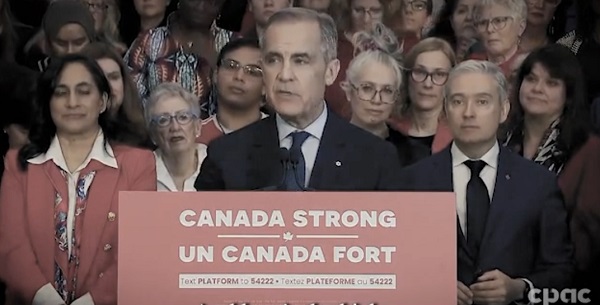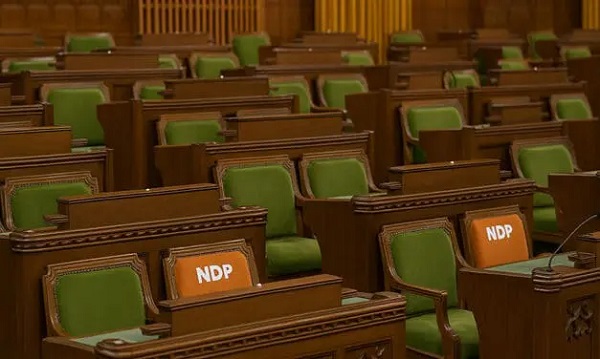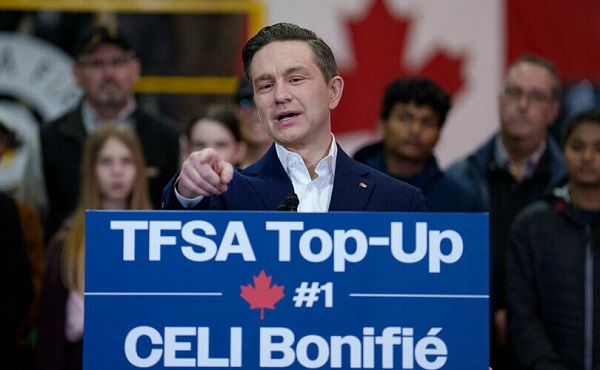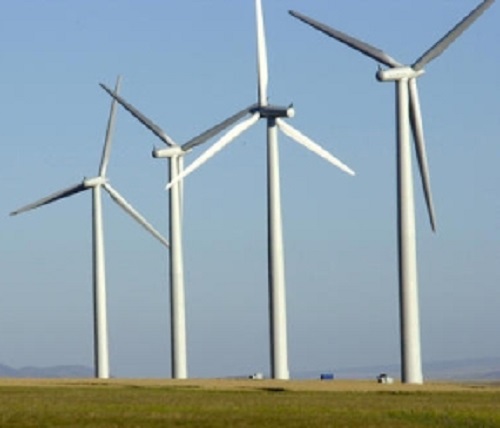2025 Federal Election
Campaign 2025 : The Liberal Costed Platform – Taxpayer Funded Fiction


 Dan Knight
Dan Knight
Carney is trying to redefine the deficit by splitting it into two categories: “operating” and “capital”—a little trick borrowed from UK public finance to confuse voters and dodge political accountability. It’s not something Canada has ever used in federal budget reporting, and there’s a reason for that: it’s misleading by design.
Mark Carney, the unelected banker-turned-savior of the Liberal Party, stood on a stage at Durham College on April 19 and did what professional economic grifters do best—he smiled politely, gestured at some numbers, and attempted to sell Canadians on a $130 billion illusion.
He called it a “costed platform.” What it really was, was a pitch deck for national decline—a warmed-over slab of recycled Trudeauism, backed by deficit delusion and framed as “bold leadership.”
And yes, the numbers are real. Terrifyingly real.
The Liberal platform promises $130 billion in new spending over four years, while running deficits of $62.3 billion this year, $59.9 billion next year, and still sitting at $48 billion in the red by 2028. To balance all of this out? A magical $28 billion in “unspecified cuts.” Not outlined. Not itemized. Just floated in the air like a promise from a door-to-door vacuum salesman.
Carney, in his perfectly rehearsed banker tone, assures us it’s not spending. No, it’s “investment.” Which is hilarious, because that’s exactly what Justin Trudeau said when he kicked off a decade of reckless spending, capital flight, and housing inflation. Carney has simply pulled off the Liberal magic trick of rebranding debt as growth.
But this isn’t just fiscal mismanagement. This is coordinated, high-level dishonesty.
Let’s be clear: Mark Carney is not new to any of this. He isn’t some white knight riding in to clean up Trudeau’s mess. He is the mess. He was Trudeau’s economic consigliere. He sat in the backrooms when they passed Bill C-69, which throttled Canada’s energy sector. He championed ESG, oversaw the implosion of GFANZ (his climate finance alliance), and helped drive $500 billion in investment out of this country.
Now he’s back—wearing a new title, making the same promises, using the same playbook. Only this time, he’s brought a spreadsheet.
In one breath, Carney says we need to “diversify trade.” In the next, he’s counting on $20 billion in one-time countertariff revenues to prop up his platform. In one paragraph, he says Canada will be “fiscally responsible.” In the next, he admits the deficit will nearly double this year. He claims he’ll spend 2% of GDP on defense—but not until 2029, because, of course, there’s no urgency when you’re protected by the American military umbrella you secretly resent.
And his housing plan? If you thought things couldn’t get worse than Justin Trudeau’s housing disaster, buckle up. Carney’s solution is modular housing—yes, government-subsidized, prefabricated micro-boxes dropped onto federally controlled land.
Mark Carney will never live in modular housing. His children will never live in modular housing. But for you, the taxpayer? That’s the future he envisions—managed housing, managed economy, managed speech, managed life.
He’s not here to lift Canadians up. He’s here to lock them down—into a permanent, bureaucratically engineered middle class, dependent on state subsidies and grateful for whatever dignity Ottawa hasn’t yet taxed away.
And when asked how he’ll find the $28 billion in cuts needed to make this plan remotely plausible, his answer was priceless:
“Technology, attrition, and a review of consultant contracts.”
Translation: “We don’t know.”
And here’s where the grift goes full throttle—the accounting scam.
Carney is trying to redefine the deficit by splitting it into two categories: “operating” and “capital”—a little trick borrowed from UK public finance to confuse voters and dodge political accountability. It’s not something Canada has ever used in federal budget reporting, and there’s a reason for that: it’s misleading by design.
Here’s how it works: Carney claims that by 2028, the government will run an “operating surplus.” Sounds responsible, right? Like the books are balanced?
Wrong.
Because even while he’s claiming an “operating surplus,” the federal government will still be running a $48 billion deficit overall. That’s real debt—borrowed money the country doesn’t have.
So how does he square the circle?
Simple: he relabels infrastructure and program spending as “capital investment”, pushes it off to the side, and tells you the main budget is in good shape.
But guess what?
You still owe the money.
The debt still grows.
And interest payments still stack up.
It’s like maxing out your credit card, then saying “no problem—I only overspent on long-term purchases, not day-to-day expenses.”
Try that line with your bank. Let me know how it goes.
This isn’t honest budgeting. It’s spreadsheet manipulation by a guy who knows how to massage the optics while the house burns down.
And let’s not forget who we’re talking about here.
This is the man who moved his financial headquarters to New York while lecturing Canadians about economic sovereignty.
This is the guy with a Cayman Islands tax haven, who built his fortune offshore and now wants to manage your budget while shielding his own.
This is the architect of GFANZ—the so-called climate finance alliance—that imploded under his leadership. The same alliance that saw JPMorgan, Citigroup, and the Big Six Canadian banks bail because Carney couldn’t keep the cartel together without running afoul of antitrust laws.
This is the same man mentioned in Marco Mendicino’s Emergencies Act texts—the man who said, Move the tanks on the protesters.
That’s right.
He wasn’t calling for dialogue. He wasn’t calling for democracy. He was calling for force—on peaceful Canadians exercising their rights. That’s who this is.
So let’s drop the fantasy.
Mark Carney isn’t here to save you.
2025 Federal Election
NDP’s collapse rightly cost them official party status

This article supplied by Troy Media.
 By Michael Taube
By Michael Taube
Official party status requires 12 seats. The NDP got seven. End of story
Rules are rules.
That, in a nutshell, is why the NDP wasn’t granted official party status in the House of Commons on Monday. Prime Minister Mark Carney and the
Liberals, to their credit, made the right decision.
Let’s examine why.
The 1963 Senate and House of Commons Act passed an amendment that gave an annual allowance to party leaders other than the prime minister and
leader of the Opposition. In doing so, the Canadian government had to establish what constitutes a “political party.” The definition they came up with was a sensible one: it had to have a “recognized membership of 12 or more persons in the House of Commons.”
This important amendment is still used today.
The NDP fell from 24 to a paltry seven seats in last month’s federal election. (There are a total of 343 seats in the House of Commons.) They finished with 1,234,673 votes, or 6.29 per cent, which was behind the Liberals, Conservatives and Bloc Québécois. Party leader Jagmeet Singh, who had represented the former Burnaby South riding since 2019, finished a distant third in the newly created Burnaby Central riding and resigned.
The NDP’s seven seats is well below the 12-seat requirement needed for official party status. This means Canada’s socialist alternative won’t be able to ask questions in the House of Commons and will lose out on money for research purposes.
Or, to put it another way, they’re plumb out of luck.
Hold on, some people said. They pointed out that the NDP’s seat count and popular vote only plummeted because many progressive voters backed Carney and the Liberals as the best option to counter U.S. President Donald Trump and his tariffs. They felt that the NDP’s long history as a champion for unions and the working class should count for something. They suggested there should be an exception to the rule.
Guess what? They’re wrong.
This is the worst election result in the party’s history. Even its predecessor, the Co-operative Commonwealth Federation (CCF), did marginally better in its first campaign. The CCF won seven out of 245 seats—and earned 410,125 votes, or 9.31 per cent—in the 1935 election. Party leader J.S. Woodsworth, who had represented the riding of Winnipeg North Centre as an Independent Labour MP since 1925, comfortably held his seat.
Meanwhile, this won’t be the first time they’ve ever lost official party status.
The NDP dropped from 43 to nine seats in the 1993 election. It was a dismal showing, to say the least. There was a suggestion at the time that then-party leader Audrey McLaughlin, the first woman to lead a party with political representation in Canada’s House of Commons, deserved a better fate. While the NDP certainly came closer to achieving the 12-seat requirement in this particular election, Prime Minister Jean Chrétien and the Liberals decided against granting them official party status.
Why? As I mentioned earlier, rules are rules.
Then again, British pilot Harry Day notably told his fellow flying ace Douglas Bader in 1931, “You know my views about some regulations—they’re written for the obedience of fools and the guidance of wise men.”
Does this mean that individuals and organizations who follow rules are, in fact, fools? Not at all. While certain rules in a liberal democratic society can range from slightly questionable to utterly ridiculous, they’re usually put in place for a specific purpose.
In the case of the House of Commons, it’s to ensure that a bar has been set with respect to political representation. Is 12 seats the right number? That’s difficult to say. It certainly prevents small protest parties and one-issue parties that unexpectedly win a tiny number of seats in an election from acquiring power and status right off the bat. They need to win more seats and grow in size and stature to reach a point of respectability. Most of them never reach this point and disappear while others float in a constant state of mediocrity like the Green Party of Canada. ’Tis the nature of the political beast.
One final point. If Singh and the NDP had reached double digits in total number of seats in 2025, a solid case could have been made in favour of official party status. If they had finished with 11 seats, it would have almost been a lock. Neither scenario ultimately materialized, which is why Carney and the Liberals did exactly what they did.
Michael Taube is a political commentator, Troy Media syndicated columnist and former speechwriter for Prime Minister Stephen Harper. He holds a master’s degree in comparative politics from the London School of Economics, lending academic rigour to his political insights.
Troy Media empowers Canadian community news outlets by providing independent, insightful analysis and commentary. Our mission is to support local media in helping Canadians stay informed and engaged by delivering reliable content that strengthens community connections and deepens understanding across the country.
2025 Federal Election
Judicial recounts give Conservatives 2 more seats, keeping Liberals short of majority

From LifeSiteNews
After a judicial recount, Conservative candidate Kathy Borrelli has officially won over Liberal incumbent Irek Kusmierczyk, in the Ontario riding of Windsor-Tecumseh-Lakeshore.
Judicial recounts from the 2025 federal election have given the Conservative Party two new seats, with one candidate winning by just four votes.
After a judicial recount, Conservative candidate Kathy Borrelli has officially won over Liberal incumbent Irek Kusmierczyk, in the Ontario riding of Windsor-Tecumseh-Lakeshore.
Borrelli got 32,090 votes, with Kusmierczyk getting 32,086 votes, and NDP candidate Alex Ilijoski getting 4,240 votes.
In the Newfoundland riding of Terra Nova-The Peninsulas, Conservative candidate Jonathan Rowe beat out Liberal Anthony Germain by just 12 votes after a recount with the initial result showing a Liberal victory.
The new election results mean the Conservatives now have 144 seats with the Liberals at 169, three short of a majority.
Judicial recounts are automatically triggered when the margin of victory for a candidate is less than 0.1 percent of valid votes.
While these recounts have favored the Conservatives, others have gone in the Liberal Party’s favor.
A May 16 judicial recount switched the southern Ontario riding of Milton East-Halton Hills South to the Liberals with a 21-vote victory over the Conservatives.
Overall, the election results have been a big blow to the Conservative Party, which on top of losing the election also saw its leader, Pierre Poilievre, fail to win his long-held seat. However, Poilievre is expected to run in a yet-to-be-announced by-election in Alberta to reclaim a seat in Parliament.
-

 Censorship Industrial Complex2 days ago
Censorship Industrial Complex2 days agoFreedom of speech under threat on university campuses in Canada
-

 Alberta1 day ago
Alberta1 day agoOttawa’s destructive federal energy policies and Premier Danielle Smith’s three part solution
-

 Business2 days ago
Business2 days agoCarney engaging in Orwellian doublethink with federal budget rhetoric
-

 Alberta2 days ago
Alberta2 days agoIs Alberta getting ripped off by Ottawa? The numbers say yes
-

 Energy2 days ago
Energy2 days agoCanada’s LNG breakthrough must be just the beginning
-

 Business2 days ago
Business2 days agoCourt’s ‘Aboriginal title’ ruling further damages B.C.’s investment climate
-

 Agriculture1 day ago
Agriculture1 day agoIn the USA, Food Trumps Green Energy, Wind And Solar
-

 Business2 days ago
Business2 days agoManitoba Must Act Now To Develop Its Northern Ports



